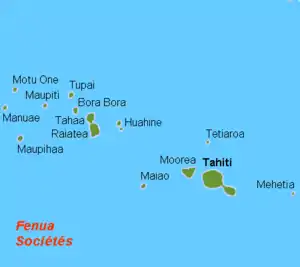Maupihaa
Maupihaa, also known as Mopelia, is an atoll in the Leeward group (Iles sous le Vent) of the Society Islands. This atoll is located 72 km southeast of Manuae, its nearest neighbor.
 NASA picture of the island of Maupihaa Atoll | |
 | |
| Geography | |
|---|---|
| Location | Pacific Ocean pito |
| Coordinates | 16°48′S 153°57′W |
| Archipelago | Society Islands |
| Area | 2.6 km2 (1.0 sq mi) |
| Administration | |
France | |
| Overseas collectivity | French Polynesia |
| Administrative subdivision | Leeward Islands |
| Demographics | |
| Population | 10 (1985) |
| Pop. density | 4/km2 (10/sq mi) |
Geography
Maupihaa atoll is roughly 8 km in length and contains a lagoon that is up to 40 m in depth and is surrounded by submerged reefs on three sides.[1] The atoll's outer reefs are continuous except for a small passage on the western side of the atoll. The eastern side consists of a narrow, thickly vegetated, islet (Motu Maupihaa) and a number of smaller islets bring the total land area of Maupihaa to 2.6 km2. The only village on the atoll is located on Motu Maupihaa and as of 1985, the population consisted of just 10 people.[2]
History

Maupihaa Atoll was inhabited in very ancient times by Polynesians; archaeological remains and fish hooks have been found. The first European to arrive on Maupihaa, along with neighboring Fenua Ura and Motu One, was Samuel Wallis in 1767. In 1917, the atoll was leased to a Papeete company, with three employees producing copra, and raising pigs and chickens and collecting turtles. It was later leased to another copra company and entirely planted with coconut palms.
In the same year, Count Felix von Luckner of the famed SMS Seeadler visited the island and established a small colony during his voyage to raid Allied shipping in the South Pacific during the First World War. The purpose of the stop was to obtain water and fresh stores and to make repairs to the Seeadler's hull after a long journey through the Atlantic Ocean and around South America. Since SMS Seeadler was too large to enter Mopelia lagoon, she was anchored on the outside of the atoll. After a short time, rough seas and wind caused the Seeadler to run aground on Mopelia's reef, leaving von Luckner and about 50 others marooned. In Lowell Thomas' 1928 book on von Luckner he reports that the loss of Seeadler was the consequence of a tsunami.
Some of the stranded sailors were American prisoners of war who were captured on the ocean by Luckner's raiders. Eventually von Luckner chose a few men and rigged a long boat with a sail to journey about 2,000 mi (3,200 km) to the Fiji Islands where von Luckner intended to capture another sailing ship and go back and rescue the remaining seamen on Mopelia. However, the plan did not work very well, for while von Luckner was able to reach his destination, he ended up surrendering to a British lieutenant. Von Luckner spent the rest of World War I as a POW in New Zealand, though he successfully escaped on one occasion, absconding on the boat of the prison warden with several other prisoners, only to be recaptured later. Meanwhile, the rest of his crew captured a French schooner, Lutece, which called at Mopelia, and sailed it to Easter Island arriving on 4 October and running aground there, after which they were interned by the Chilean authorities. Four American seamen then sailed an open boat 1,000 mi (1,600 km) to Pago Pago, where they arranged for their colleagues' rescue from Mopelia.
Administration
The atoll is administratively part of the commune (municipality) of Maupiti, itself in the administrative subdivision of the Leeward Islands. Presently Maupihaa is listed as permanently uninhabited.
Alternate names
- Mopelia
- Maupelia
- Mopihaa
- Maupihoa
- Mapetia
See also
- Desert island
- List of islands
References
- "Society Islands - Maupihaa". oceandots.com. 2007-01-14. Archived from the original on December 23, 2010.
- "Living Archipelagos - Proposed Sites". livingarchipelagos.org. 2007-01-14. Archived from the original on 2007-06-11.